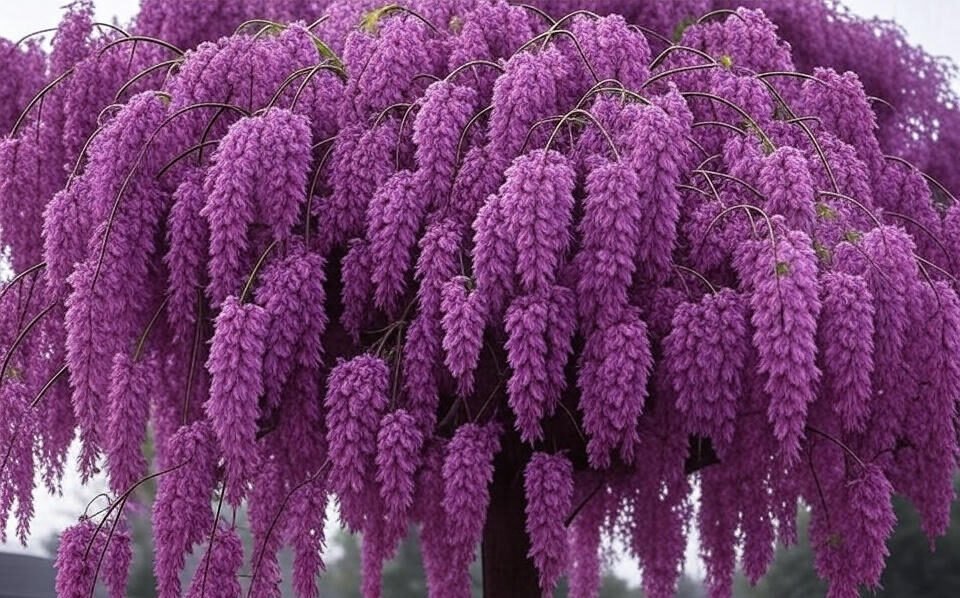The weeping purple flower tree captures the hearts of gardeners looking to add vibrant color and elegant form to their landscapes. Commonly known as the weeping redbud, this tree is a variety of the eastern redbud (Cercis canadensis), a native North American species celebrated for its striking spring blooms and graceful, drooping branches. With its cascading shape and vivid purple-pink flowers, the weeping redbud transforms yards into breathtaking displays, especially in spring when it bursts into bloom before its leaves emerge. This tree suits small gardens, patios, or pathways due to its compact size and low maintenance needs. It attracts pollinators like bees and butterflies, adding life to any outdoor space. You’ll discover everything about the weeping redbud, from its unique characteristics and popular varieties to planting tips, care routines, and creative landscaping ideas. Whether you’re a seasoned gardener or a beginner, this article provides all the information needed to grow and enjoy this beautiful tree in your own backyard.
Understanding the Weeping Redbud Tree
The weeping redbud stands out for its distinctive appearance and adaptability. Unlike standard redbud trees that grow upright, the weeping varieties feature branches that arch downward, creating a fountain-like silhouette that adds drama to any garden. Scientifically classified as Cercis canadensis, this tree thrives across a wide range of climates, performing well in USDA hardiness zones 5 through 9, which cover much of the United States from chilly northern winters to warm southern summers. Its ability to tolerate varied conditions makes it a favorite for homeowners seeking beauty without excessive upkeep. The weeping redbud grows slowly, reaching a modest height and spread, which ensures it fits perfectly in smaller spaces without overwhelming the landscape.
Key Characteristics of the Weeping Redbud
The weeping redbud’s charm lies in its seasonal transformations. In early spring, before leaves appear, clusters of small, vibrant purple-pink flowers blanket the branches, creating a stunning display that lasts two to three weeks. These blooms attract pollinators, making the tree a haven for bees and butterflies. Once the flowers fade, heart-shaped leaves emerge, typically green but sometimes deep purple, depending on the variety. By fall, the foliage shifts to warm shades of yellow or red, adding another layer of visual interest. In winter, the bare, weeping branches reveal the tree’s graceful structure, with smooth gray bark that peels slightly for added texture. This year-round appeal ensures the weeping redbud remains a focal point in any season.
Unique Growth Habit
The defining feature of the weeping redbud is its cascading growth habit. Branches naturally droop, forming a curtain-like effect that creates shade beneath and draws the eye. Young trees may need staking to encourage this weeping form, but as they mature, the branches develop their characteristic arch. The tree grows to a height of 6 to 10 feet and spreads about the same distance, making it ideal for small yards or as an accent near garden features. Its roots spread wide but stay shallow, allowing it to tolerate dry spells once established, though it prefers well-drained soil to avoid waterlogged roots.
Popular Varieties of the Weeping Redbud
Several cultivated varieties of the weeping redbud offer unique colors and forms to suit different garden styles. Each brings slight variations in flower shade, leaf color, or growth pattern, giving you options to match your vision.
Ruby Falls Redbud
The Ruby Falls weeping redbud is a standout for its deep purple foliage and rosy-purple flowers. Growing to about 8 feet tall, this variety maintains its rich leaf color through summer, making it a bold choice for gardeners who want a dramatic contrast in their landscape. Its vibrant blooms and compact size make it perfect for focal points or mixed borders.
Lavender Twist Redbud
The Lavender Twist, another popular choice, features light pink flowers and slightly twisted branches that enhance its weeping form. This variety stays smaller, typically reaching 5 to 6 feet, and fits well in modern or minimalist gardens. Its delicate blooms and unique branch structure add a whimsical touch to any space.
Other Notable Varieties
For those seeking variety, the Vanilla Twist redbud offers rare white flowers, creating a softer look compared to its purple-flowered cousins. The Golden Falls variety introduces golden-yellow leaves, providing a bright contrast to green lawns or shrubs. Another option, the Traveler redbud, boasts burgundy foliage for a rich, moody aesthetic. Each variety has slight differences in disease resistance or growth rate, so consult local nurseries to find the best fit for your climate and soil conditions.
Planting Your Weeping Redbud
Planting a weeping redbud requires careful planning to ensure it thrives for years. The best times to plant are spring or fall, when cooler temperatures reduce stress on the young tree and help roots establish before extreme heat or cold. Start by selecting a healthy tree from a reputable nursery, checking for a straight trunk, undamaged branches, and a well-formed root ball.
Choosing the Perfect Location
Location is critical for a healthy weeping redbud. Choose a spot with full sun or partial shade, ensuring at least four hours of direct sunlight daily to promote abundant flowering. The soil must drain well to prevent root rot, which can occur in heavy clay or waterlogged areas. To test drainage, dig a hole 12 inches deep, fill it with water, and observe how quickly it drains. If the water lingers for hours, amend the soil with compost or sand to improve drainage. Avoid planting in low-lying areas prone to pooling water, and keep the tree at least 10 feet from buildings or other trees to give roots room to spread. A wind-sheltered spot helps protect young trees from damage.
Step-by-Step Planting Process
Begin by digging a hole twice as wide as the root ball and equal in depth to ensure proper root placement. Gently remove the tree from its container, loosening any tangled roots to encourage outward growth. Place the tree in the hole, ensuring the top of the root ball sits level with the surrounding ground. Backfill the hole with native soil, pressing firmly to eliminate air pockets. Water thoroughly immediately after planting to settle the soil and hydrate the roots. Apply a 2-inch layer of mulch, such as wood chips or compost, around the base, keeping it a few inches from the trunk to prevent rot. For young trees with floppy branches, use soft ties and stakes to guide the weeping shape, removing them after the first year. Monitor the soil level over the first few weeks, adding more if the ground settles.
Caring for Your Weeping Redbud
Maintaining a weeping redbud is straightforward, as it requires minimal effort once established. Regular checks and basic care keep it healthy and vibrant throughout its life.
Watering and Fertilizing
Newly planted weeping redbuds need consistent watering to establish strong roots. Provide about one inch of water weekly during the first year, especially if rainfall is scarce. Check the soil 2 inches below the surface; if it feels dry, water deeply to reach the roots. Mature trees tolerate drought better and only need watering during extended dry periods. Overwatering can harm the tree, so ensure the soil drains well to avoid soggy conditions. Fertilize in early spring if growth appears slow or leaves look pale, using a balanced fertilizer spread evenly under the canopy. Organic compost or mulch applied annually also enriches the soil naturally, reducing the need for synthetic fertilizers.
Pruning for Health and Shape
Pruning keeps the weeping redbud tidy and enhances its natural form. The best time to prune is late spring, after flowering ends, to avoid cutting off next year’s buds. Use sharp, clean pruning shears to remove dead, damaged, or crossing branches, cutting just above a bud or branch junction. For young trees, light pruning helps guide the weeping shape, but avoid heavy cuts that stress the tree. In winter, you can make structural changes if needed, though most maintenance happens in spring. Always clean tools between cuts to prevent disease spread. If the tree’s branches touch the ground, trim them slightly to maintain the desired shape.
Managing Pests and Diseases
While the weeping redbud resists most issues, occasional pests and diseases require attention. Common pests include borers, which create small holes in the trunk, leaving sawdust-like frass. If detected, apply targeted insecticides and remove affected branches. Scale insects, appearing as small bumps on stems, can be washed off with soapy water. Leafhoppers and caterpillars may eat foliage, causing yellowing or holes; hand-pick caterpillars or use organic sprays for control. Deer sometimes nibble young shoots, so use netting or repellents in areas with wildlife. Diseases like canker, which causes sunken bark spots, require pruning and disposal of infected parts. Leaf spot, a fungal issue, appears as brown patches on leaves; rake up fallen debris and apply fungicide if severe. Verticillium wilt, a soil-borne fungus, may yellow leaves and kill branches, with no cure in advanced cases—choose resistant varieties to minimize risk. Proper drainage prevents root rot, another potential issue in poorly drained soils.
Landscaping with the Weeping Redbud
The weeping redbud shines as a versatile landscaping element. Its compact size and dramatic shape make it an ideal focal point near pathways, benches, or patios, where its spring blooms and cascading branches can be admired up close. Pair it with evergreen shrubs or groundcovers to contrast its vibrant flowers and foliage. In small gardens, a single tree creates a stunning centerpiece, while grouping three or more in larger spaces amplifies the spring display with a mix of flower colors from different varieties. The tree’s ability to attract pollinators adds ecological value, supporting local bees and butterflies. In fall, its colorful leaves complement autumn beds, and in winter, the bare branches provide structural beauty, especially in snowy landscapes. For container gardening, plant a dwarf variety like Lavender Twist in a large pot with good drainage, placing it on a patio for a portable accent.
Conclusion
The weeping redbud, often called the weeping purple flower tree, offers unmatched beauty with minimal effort. Its vibrant spring blooms, heart-shaped leaves, and graceful weeping form make it a standout in any garden. By choosing the right location, planting carefully, and providing basic care, you can enjoy this tree’s charm for decades. Whether you’re enhancing a small yard or creating a bold landscape feature, the weeping redbud delivers year-round interest and ecological benefits. Plant one today and watch it transform your outdoor space into a haven of color and elegance.














